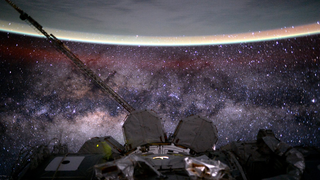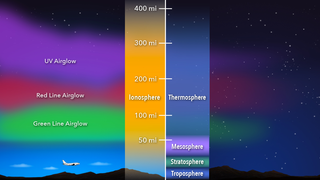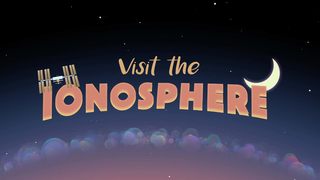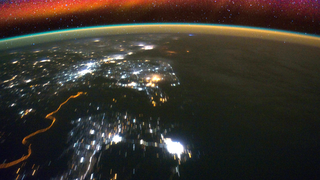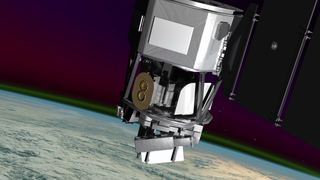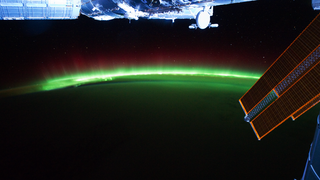Sun
ID: 12902
What does our planet look like from space? Most are familiar with the beloved images of the blue marble or pale blue dot — Earth from 18,000 and 3.7 billion miles away, respectively. But closer to home, within the nearest region of space, you might encounter an unfamiliar sight. If you peer down on Earth from just 300 miles above the surface, near the orbit of the International Space Station, you can see vibrant swaths of red and green or purple and yellow light emanating from the upper atmosphere. This is airglow.
The Secrets behind Earth’s Multi-colored Glow
Airglow occurs when atoms and molecules in the upper atmosphere, excited by sunlight, emit light in order to shed their excess energy. Or, it can happen when atoms and molecules that have been ionized by sunlight collide with and capture a free electron. In both cases, they eject a particle of light — called a photon — in order to relax again. The phenomenon is similar to auroras, but where auroras are driven by high-energy particles originating from the solar wind, airglow is energized by day-to-day solar radiation.
Source Material
Related
For More Information
Credits
Scientists:
Sarah L. Jones (NASA/GSFC)
Scott England (Space Sciences Laboratory, University of California at Berkeley)
Producer:
Joy Ng (USRA)
Animators:
Krystofer Kim (USRA)
Joy Ng (USRA)
Writer:
Kathalina Tran (SGT)
Graphic Designer:
Mary P. Hrybyk-Keith (TRAX International)
Sarah L. Jones (NASA/GSFC)
Scott England (Space Sciences Laboratory, University of California at Berkeley)
Producer:
Joy Ng (USRA)
Animators:
Krystofer Kim (USRA)
Joy Ng (USRA)
Writer:
Kathalina Tran (SGT)
Graphic Designer:
Mary P. Hrybyk-Keith (TRAX International)
Please give credit for this item to:
NASA's Goddard Space Flight Center
NASA's Goddard Space Flight Center
Short URL to share this page:
https://svs.gsfc.nasa.gov/12902
This item is part of this series:
Narrated Movies
Keywords:
SVS >> HDTV
GCMD >> Earth Science >> Sun-earth Interactions >> Ionosphere/Magnetosphere Particles
GCMD >> Earth Science >> Atmosphere >> Atmospheric Radiation >> Airglow
GCMD >> Location >> Ionosphere
SVS >> ISS
NASA Science >> Sun
GCMD >> Earth Science >> Sun-earth Interactions >> Ionosphere/Magnetosphere Dynamics
SVS >> Icon
SVS >> Gold
GCMD keywords can be found on the Internet with the following citation: Olsen, L.M., G. Major, K. Shein, J. Scialdone, S. Ritz, T. Stevens, M. Morahan, A. Aleman, R. Vogel, S. Leicester, H. Weir, M. Meaux, S. Grebas, C.Solomon, M. Holland, T. Northcutt, R. A. Restrepo, R. Bilodeau, 2013. NASA/Global Change Master Directory (GCMD) Earth Science Keywords. Version 8.0.0.0.0
https://svs.gsfc.nasa.gov/12902
This item is part of this series:
Narrated Movies
Keywords:
SVS >> HDTV
GCMD >> Earth Science >> Sun-earth Interactions >> Ionosphere/Magnetosphere Particles
GCMD >> Earth Science >> Atmosphere >> Atmospheric Radiation >> Airglow
GCMD >> Location >> Ionosphere
SVS >> ISS
NASA Science >> Sun
GCMD >> Earth Science >> Sun-earth Interactions >> Ionosphere/Magnetosphere Dynamics
SVS >> Icon
SVS >> Gold
GCMD keywords can be found on the Internet with the following citation: Olsen, L.M., G. Major, K. Shein, J. Scialdone, S. Ritz, T. Stevens, M. Morahan, A. Aleman, R. Vogel, S. Leicester, H. Weir, M. Meaux, S. Grebas, C.Solomon, M. Holland, T. Northcutt, R. A. Restrepo, R. Bilodeau, 2013. NASA/Global Change Master Directory (GCMD) Earth Science Keywords. Version 8.0.0.0.0
